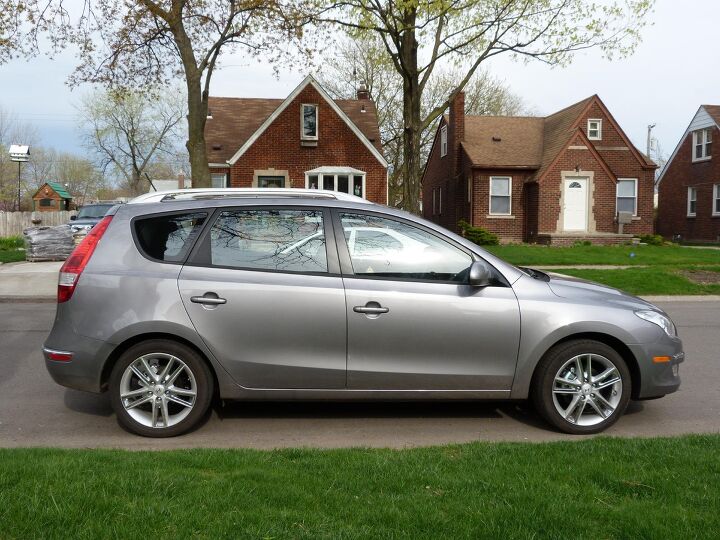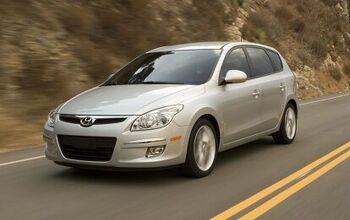Review: 2011 Hyundai Elantra Touring SE
You’re an old fart. Or at least you think like one. You want a simply designed car that’s easy to see out of, capable of toting a bunch of stuff, solidly constructed, and fun to drive. Meanwhile, cars keep going in the opposite direction, with sci-fi styling, shrunken windows, oversized and overcomplicated instrument panels, cramped rear seats, and marshmallow suspension tuning (e.g. the Honda Civic reviewed a few days ago). But before giving up hope you might want to check out the Hyundai Elantra Touring SE.
What is the Elantra Touring? One clue: originally developed for the European market, it’s badged the i30 Estate in the UK. “Estate” is Brit speak for wagon. An i30 hatch is also offered over there, but hasn’t been imported. Compared to that car, the lengthier i30 Estate / Elantra Touring (106.3 vs. 104.3 wheelbase, 176.2 vs. 168.5 overall length) is a wagon. But, with the proportions of a hatchback and an upward curve abbreviating the rearmost window, it’s not a wagon to American eyes. Interior space is comparable to that of a compact crossover, but without the 65-plus-inch height of a crossover. Instead, with a roofline 59.8 inches above the pavement, the Elantra Touring pushes the upper limits of a conventional car. Of the cars offered in the U.S., the Scion xB and Toyota Matrix come closest to direct competition, but they’re shorter in length, taller in height, and don’t feel nearly as much like a conventional car from the driver’s seat. The Elantra Touring is in a size class by itself, which is both a strength (no direct competition) and a weakness (few people know to look for one).
Compounding the challenge: as a Euro-market car, the Elantra Touring was only loosely related to the 2007-2010 US-market Elantra sedan, and has little in common with the redesigned 2011. Trying to market two disparate cars using the same nameplate tends to result in one of them getting lost. Even up against the previous Elantra sedan, which itself failed to attract the attention of many American car buyers, the Elantra Touring struggled to break through. Now that the look-at-me 2011 Elantra has arrived, the Elantra Touring is hopelessly eclipsed, at least until it’s also redesigned. So it should come as no surprise that for each of the Elantra Tourings sold (about 1,500 a month), over ten sedans fly off the lot. And the ratio would be even higher if dealers had more sedans to sell.
Design is a factor. Though subtly attractive in SE trim from the rear three-quarter angle, just about any other perspective leaves the Elantra Touring looking somewhat homely, especially compared to the highly styled 2011 Elantra sedan. Styling for the next generation Elantra Touring, which has already been approved, will much more strongly resemble the new sedan. This should be good for sales, but if you prefer an exterior with absolutely no controversial aspects you should get the current Elantra Touring while you still can. Just be sure to get the SE trim, which includes 17-inch alloy wheels. The GLS, with its hub-capped 15s, appears hopelessly dowdy.
Inside, the Elantra sedan is again more highly styled, with racy curves and novel switchgear, while the Elantra Touring’s simpler, more conventional design is easier to live with. The HVAC and audio controls are close at hand, large in size, and few in number. A USB connection and satellite radio are included, while Bluetooth is available as a $325 accessory. Aside from the somewhat flimsy lever for the adjustable lumbar, everything feels robust. The textured, padded upper doors and instrument panel are a nice touch. Too much black? Too bad—it’s the only interior color option. Best think of it as sporty and easy to keep clean.
If you want to pretend you’re piloting a rocketship, go elsewhere. The Elantra Touring’s driving position is high enough for excellent forward visibility but low enough that it still feels like a regular car. The windshield is more upright than that in the Elantra and the instrument panel is low and compact by current standards. The shifter resides in the conventional location rather than up on the instrument panel, as is often the case with tall hatches. Contrary to recent trends, the windows are tall. Consequently, the feel from the driver’s seat is very different from that in the Elantra, Focus, Civic, and so forth. I hope this driving position is retained with the upcoming redesign, but the odds aren’t good.
The Elantra Touring SE’s heated leather front seats, though not luxurious, are comfortable. A hard to find feature at any price: headrests with a fore-aft adjustment. The rear seat is comfortably high off the floor and includes significantly more legroom than the average compact hatch. Cargo? The Elantra Touring holds about as much as the average compact crossover and significantly more than the average compact hatch, though the specs (65.3 cubic feet vs. 45 or so, with the rear seat folded) might overstate the practical difference. Sadly, the front passenger seat does not fold forward. This would have improved an already highly functional package.
The only engine option remains the 138 horsepower 2.0-liter four-cylinder that powered the Elantra from 2004 through 2010. This mill feels spirited at low speeds, revs smoothly enough, and growls pleasantly while doing so, but even aided by a manual transmission lacks punch at the high end when saddled with 3,080 pounds. Hyundai’s new 2.4-liter four with 176 to 200 horsepower would be a welcome upgrade, but won’t happen before the redesign, if ever. The lighter (by about 260 pounds) 2011 Elantra sedan gets by with a 148-horsepower 1.8-liter. Could be worse: the most powerful engine offered in the UK is a 124-horsepower 1.6.
The Elantra Touring SE’s firm shifter, while not as precise or as slick as the best, feels better, even much better, than those in other Hyundais. Credit the standard short-throw linkage supplied by B&M and some TLC from Hyundai’s engineers. The main problem: it only gives you five gears to choose from (and the automatic has only four). With a sixth gear, the engine wouldn’t have to spin well over 3,000 rpm on the highway. Between the old engine and ratio-challenged gearbox, the EPA ratings are only 23/31, compared to 24/35 for the slightly heavier Sonata sedan and 29/40 for the Elantra sedan. I observed high 20s and low 30s on the trip computer in casual suburban driving, but suspect this was optimistic.
True to its European roots, steering in the Elantra Touring is also firmer than that in the typical Hyundai. The system’s feel isn’t as tight or precise as in a Mazda3 or Mitsubishi Lancer, but (unlike in the Elantra sedan) heft builds naturally as the wheel is turned and the car changes direction readily. The stability control intervenes sooner than it ought to, but not too aggressively. This nanny can be turned off safely—the car progressively understeers as it approaches its limits.
The Elantra Touring’s ride can become busy, even jostling over especially bad pavement, but remains smooth most of the time. Even over the rough stuff the car isn’t knocked off its line. Body motions are much better controlled than in the Elantra sedab and noise levels are fairly low (though the engine, spinning at 3,500 rpm, starts to intrude at 80 on the highway).
Lost in evaluating each of these aspects separately: though not an outstanding performer in any particular area, Elantra Touring SE is simply fun to drive. The primary controls aren’t the most nuanced, but they share a direct, firm, natural feel, and the systems they’re connected to react with a refreshing immediacy. Among non-turbocharged compact hatches, only the Mazda3 and (perhaps) the Mitsubishi Lancer are more enjoyable.
The Elantra Touring SE lists for $20,340 (including $95 for floormats). Aside from the $800 automatic transmission (not recommended) and $325 Bluetooth accessory there are no significant options. Similarly equipment a Mazda3 and it lists for about $3,600 more. Even after adjusting for feature differences (the Mazda has automatic climate control, and power driver seat, and so forth) using TrueDelta’s car price comparison tool and the gap remains over $2,000. A Toyota Matrix S is about $2,400 more before adjusting for feature differences, and about $3,800 more afterwards. A Mitsubishi Lancer Sportback GTS? $3,100 more before the adjustment, $1,700 afterwards. A Kia Forte EX, on the other hand, is very close in price.
The Elantra Touring has a smaller, less powerful engine than any of these alternatives. Its trump cards: less gimmicky styling (compared to the Mazda and Toyota), an outstanding driving position, excellent ergonomics, and a higher quality, roomier interior. The Hyundai might not triumph in any particular area, but no other car offers a similar combination of crossover functionality and hot hatch driving enjoyment. If you’ve been seeking this combination, we’ve found your car.
Hyundai provided the vehicle, insurance and one tank of gas for this review.
Michael Karesh operates TrueDelta, an online source of automotive pricing and reliability data.
Michael Karesh lives in West Bloomfield, Michigan, with his wife and three children. In 2003 he received a Ph.D. from the University of Chicago. While in Chicago he worked at the National Opinion Research Center, a leader in the field of survey research. For his doctoral thesis, he spent a year-and-a-half inside an automaker studying how and how well it understood consumers when developing new products. While pursuing the degree he taught consumer behavior and product development at Oakland University. Since 1999, he has contributed auto reviews to Epinions, where he is currently one of two people in charge of the autos section. Since earning the degree he has continued to care for his children (school, gymnastics, tae-kwan-do...) and write reviews for Epinions and, more recently, The Truth About Cars while developing TrueDelta, a vehicle reliability and price comparison site.
More by Michael Karesh
Latest Car Reviews
Read moreLatest Product Reviews
Read moreRecent Comments
- Tassos Jong-iL The Peninsula of One Korea.
- Eric No, I just share my opinions. I have no use nor time for rhetoric from any side.
- Redapple2 Jeez. This is simple. I 75 and 696 area. 1 nobody -NOBODY wants to work in downtown Detritus. 2 close to the tech ctr. Design and Engineering HQ. 20 miles closer to Milford.3 lower taxes for the employees. Lower taxes for Evil GM Vampire.4 2 major expressways give users more options to suburbs. Faster transport.Jeez.
- Clark The Ring (Nürburgring) is the only race track I've driven on. That was 1985 or 1986 with my '73 Fiat Spider (and my not-so-happy girlfriend). So I made the Karussell (today: Caracciola Karussell, which I believe the author meant; there is another one: Kleines Karussell).
- AZFelix This article takes me back to racing electric slot cars with friends on tracks laid out in the basement. Periodically your car would stop due to lost connections or from flying off the track and you would have to dash over to it and set it right. In the mean time your competitor would race ahead until faced with a similar problem. It seemed like you were struggling harder to keep from losing than trying to win. Fun times.“History never repeats itself, but it does often rhyme.” Mark Twain
















































Comments
Join the conversation
I have a 2011 GLS with 5-speed manual and I am quite satisfied. Handles well, good gas mileage (whatever the RPM) and incredibly roomy inside for the size. As to being drab, I have no problem with drab as long as it goes hand in hand with reliable and well-built, and I have every indication that it is well-built . . . it's certainly been reliable in the time I've owned it. And the lovely electric blue color saves it from being *totally* drab. =+)
The hub-capped 2011 GLS "hopelessy dowdy?" No way. It's pleasantly austere without the pretentious sport wheels and the bling, bling. I love this car, and I found it at a very affordable price - before they shrink it next year and make it less affordable. It's too bad Hyundai did not make this more available the last couple of years - instead of near the end of its current product run.